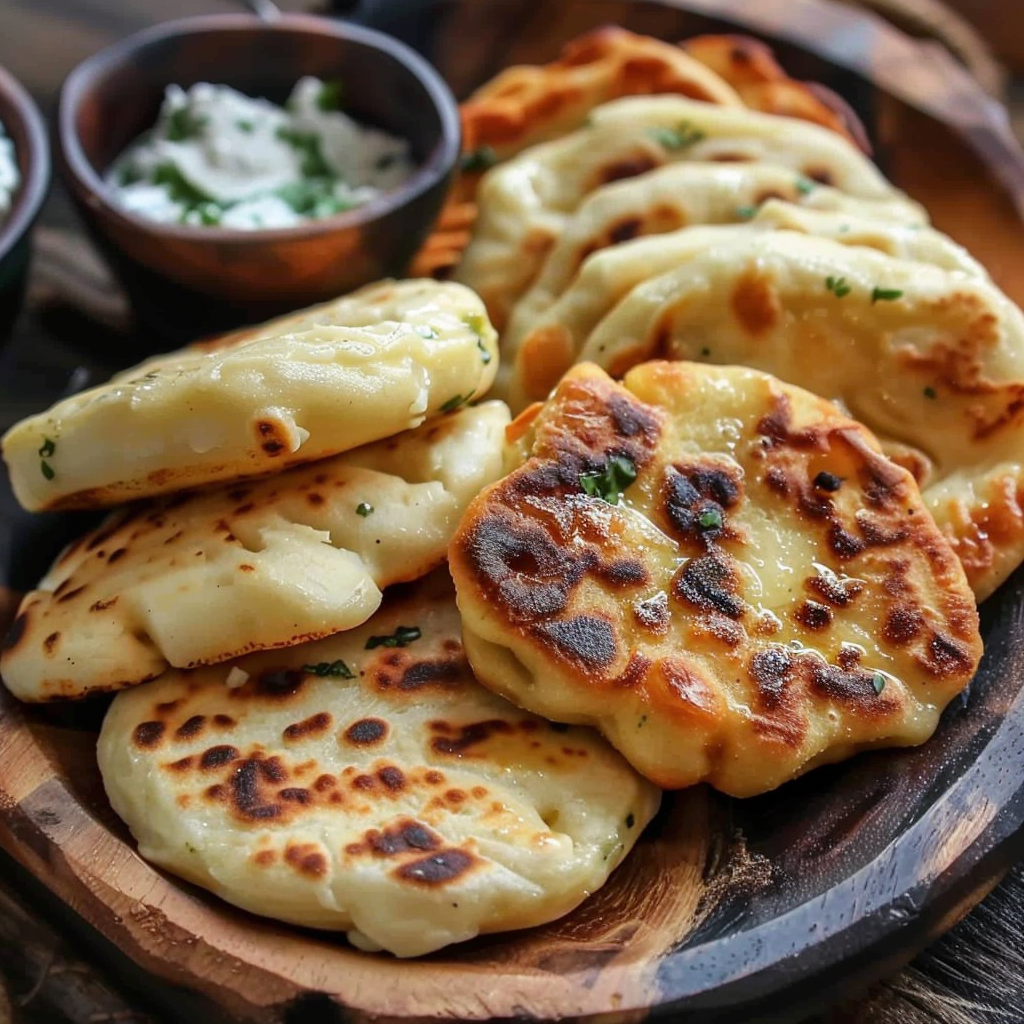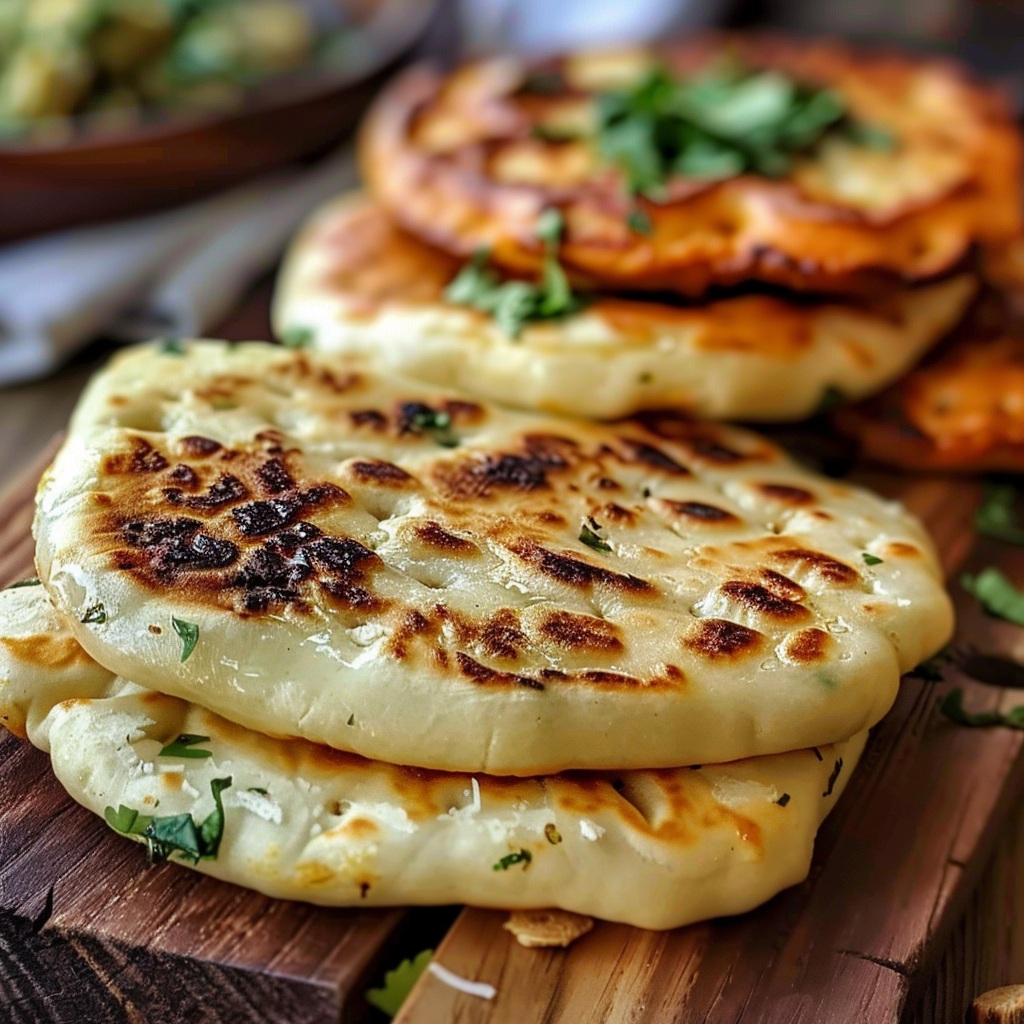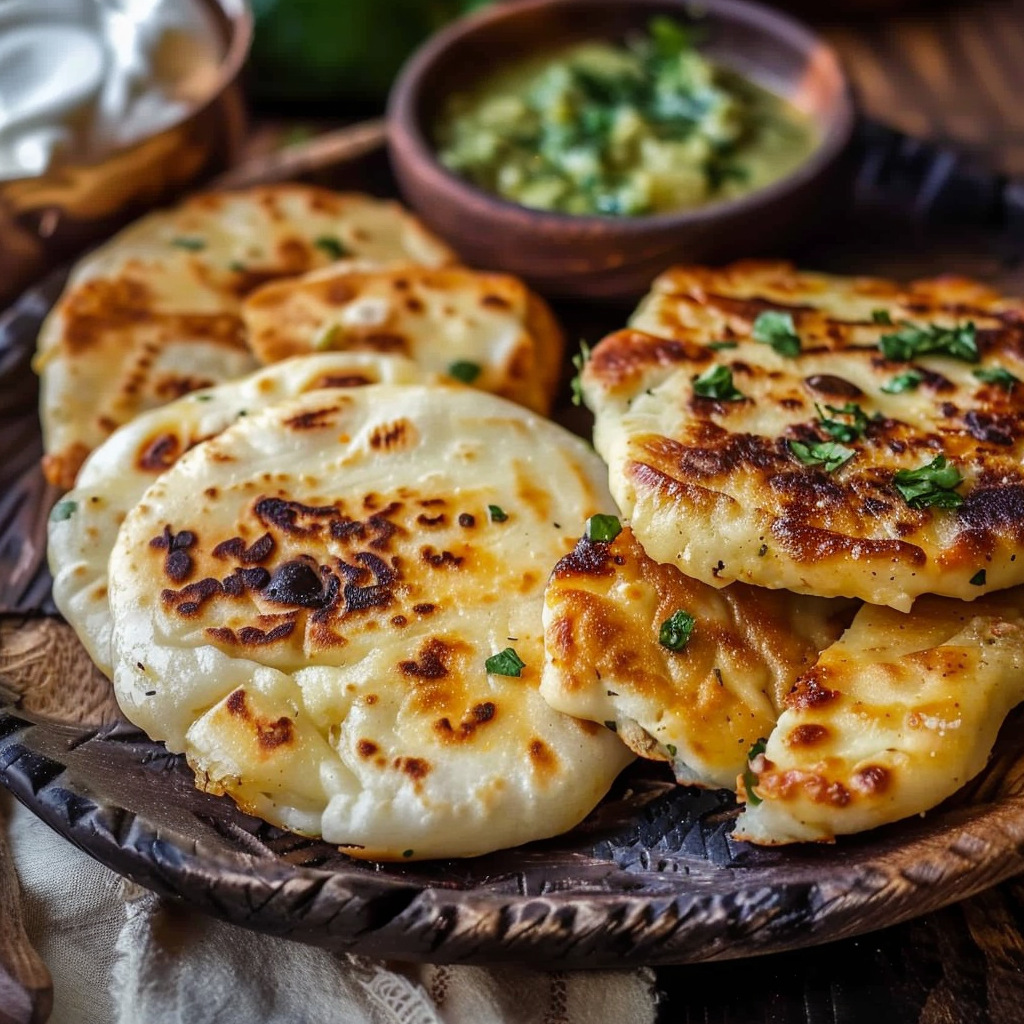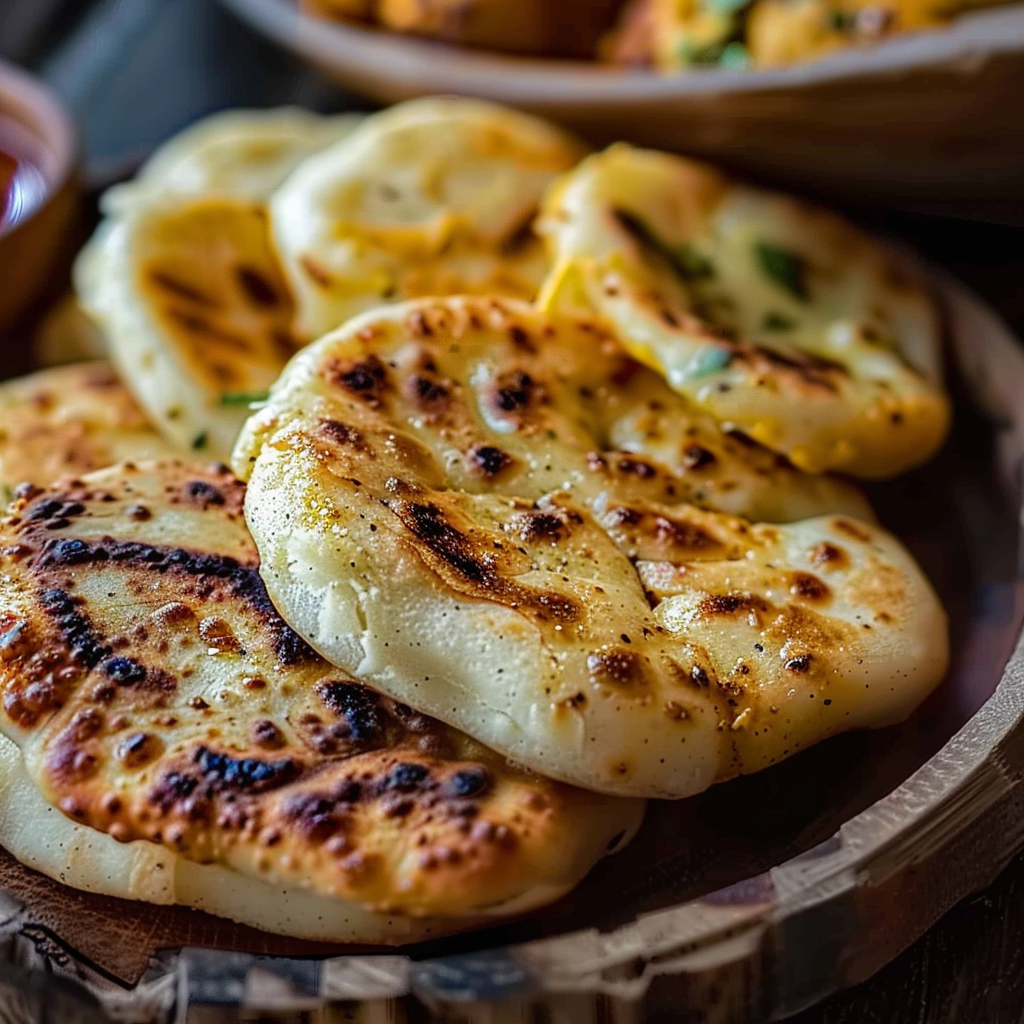Bringing Street Food Flavor to Your Home
Pupusas, a beloved dish from El Salvador, are a perfect combination of soft corn dough filled with savory ingredients and cooked to golden perfection. In this guide, you’ll learn how to prepare authentic pupusas step-by-step, along with tips for getting that street-food-quality taste at home. From making the dough to choosing the right fillings, we’ll cover all the essentials for a beginner-friendly experience. Serve them with curtido (pickled cabbage slaw) and salsa roja (tomato sauce) for a truly complete meal.

What Are Pupusas?
Pupusas are thick corn tortillas filled with a variety of ingredients, commonly including cheese, beans, meat, or a combination. Originating from El Salvador, pupusas are a staple of Salvadoran cuisine and are often enjoyed as street food. The key to a great pupusa is in the dough and the balance of flavors in the filling.
The dough for pupusas is made from masa harina, a special corn flour used in many Latin American dishes. It’s easy to work with and becomes soft and pliable when mixed with warm water. The filling options are endless—whether you prefer the classic cheese-filled variety or enjoy adding meats like ground beef or shredded chicken, there’s a pupusa for every taste.
You can make these at home with just a few ingredients, and they’ll taste just as good as the ones you find at local Salvadoran restaurants or food stands.
Ingredients for the Dough
To make the dough for your pupusas, you’ll need:
-
2 cups masa harina (corn flour)
-
1 ½ cups warm water (you may need a little more depending on dough consistency)
-
½ tsp salt
-
1 tbsp vegetable oil (optional, for softer dough)
These simple ingredients combine to create a dough that is soft, malleable, and perfect for filling. Masa harina is essential for achieving the proper texture, and you’ll be able to find it in most grocery stores, especially in the Latin American foods aisle. If you prefer a softer dough, adding a tablespoon of vegetable oil will help achieve that desired consistency.
How to Make the Dough
-
Mixing the Dough:
In a large bowl, combine the masa harina and salt. Slowly add the warm water, a little at a time, while mixing with your hands. Continue mixing until the dough is smooth and soft, but not sticky. If the dough feels dry, add more water, a tablespoon at a time, until you reach the right consistency. Masa harina dough should be pliable and easy to handle. -
Rest the Dough:
Once the dough is well-mixed, cover it with a damp cloth to prevent it from drying out while you prepare the filling. Allow it to rest for at least 10 minutes to let the flavors meld and to make it easier to work with.
Preparing the Filling
The beauty of pupusas is that the filling options are highly customizable. For a classic Salvadoran pupusa de queso (cheese-filled pupusa), you’ll need:
-
1 cup cooked ground beef, seasoned with salt, pepper, garlic powder, and a pinch of cumin
-
1 cup shredded mozzarella or queso Oaxaca
-
¼ cup finely chopped cooked refried beans (optional, for extra flavor)
If you’re using ground beef, cook it thoroughly with your preferred seasonings. The ground beef should be flavorful, but not too greasy, to avoid making the dough soggy. Queso Oaxaca is a great choice for its meltability, though mozzarella can be substituted if needed. The refried beans add moisture and flavor to the filling, making your pupusas even more satisfying.
Explore more about different fillings and their variations here.
Incorporating a variety of fillings also allows you to experiment with different textures and tastes. For example, you could add sautéed onions, peppers, or other vegetables to create a more complex flavor profile.
Shaping the Pupusas
Now that you have your dough and filling ready, it’s time to shape the pupusas. This step requires a little practice, but don’t worry—it’s all part of the fun!
-
Divide the Dough:
Start by dividing the dough into 8 equal portions, rolling each one into a ball. This will make it easier to work with and ensure consistent-sized pupusas. -
Flatten the Dough:
Take one of the dough balls and flatten it into a thick disc using your hands. The disc should be about 4-5 inches in diameter. Be careful not to flatten it too thin, as you want enough dough to hold the filling securely. -
Create a Well and Add Filling:
Gently press the center of the disc to create a small well. Place about 1-2 tablespoons of your filling into the center. Be careful not to overstuff, as too much filling may cause the dough to break when you seal it. -
Seal the Pupusa:
Carefully fold the edges of the dough over the filling, pinching and sealing them together. Once the edges are sealed, gently flatten the filled dough ball into a disc again, making sure the filling is evenly distributed inside. The key is to seal it well so that none of the filling escapes while cooking. -
Repeat for All Pupusas:
Continue this process until all the dough and filling are used. If you find the dough is sticking to your hands, you can lightly wet them with water to make the shaping process smoother.
Shaping pupusas may take some practice, but as you make more, you’ll get a feel for how much dough and filling to use for the perfect texture and size.
Cooking the Pupusas
To cook your pupusas, you’ll need a non-stick skillet or a griddle. The goal is to achieve a golden-brown, crispy exterior while keeping the inside soft and warm.
-
Preheat the Pan:
Heat your skillet or griddle over medium heat for a few minutes. If you want to add a bit of oil for extra crispiness, lightly coat the pan with a thin layer of vegetable oil. However, traditional pupusas are usually cooked without oil, which allows them to develop a slightly charred exterior. -
Cook the Pupusas:
Place each pupusa on the hot skillet. Cook for about 3-4 minutes per side, pressing them gently with a spatula to ensure they cook evenly. The pupusas should develop golden brown spots and a crispy texture on both sides. -
Flip Carefully:
When flipping the pupusas, be gentle to prevent the filling from leaking out. Use a spatula to carefully turn them over, and cook the other side until golden brown. -
Serve Hot:
Once the pupusas are cooked, serve them immediately while they’re hot and crispy.
For an authentic Salvadoran experience, serve your pupusas with curtido (pickled cabbage slaw) and salsa roja. The slaw adds a tangy, crunchy contrast to the warm and savory pupusas, and the salsa provides a vibrant burst of flavor.
Learn more about the history of Salvadoran food and pupusas to deepen your understanding of this traditional dish.
Making the Curtido (Pickled Cabbage Slaw)
A perfect complement to pupusas is curtido, a Salvadoran pickled cabbage slaw. It’s tangy, crunchy, and adds the perfect brightness to balance the rich and savory flavors of the pupusas. Here’s how to make it:
Ingredients for Curtido:
-
2 cups shredded cabbage
-
1 small carrot, julienned
-
1 small onion, thinly sliced
-
1-2 jalapeños (optional, for a little heat)
-
1 ½ cups white vinegar
-
1 cup water
-
1 tsp salt
-
1 tsp sugar
Instructions:
-
Prepare the Vegetables:
Begin by shredding the cabbage and julienning the carrot. Slice the onion thinly, and if you like a spicy kick, slice the jalapeños as well. Place all the vegetables in a large mixing bowl. -
Prepare the Vinegar Mixture:
In a small saucepan, combine the white vinegar, water, salt, and sugar. Bring it to a simmer over medium heat, stirring occasionally until the sugar and salt have dissolved completely. This step creates the brine that will pickle the vegetables. -
Pickle the Vegetables:
Once the brine has simmered and the sugar has dissolved, pour it over the shredded vegetables. Stir everything together to ensure the vegetables are evenly coated. Allow the mixture to cool to room temperature, then cover the bowl and refrigerate it for at least an hour before serving. The longer it sits, the more the flavors develop. -
Serve:
When ready to serve, the curtido will have a tangy, slightly spicy flavor that pairs perfectly with the soft, cheesy pupusas. Spoon a generous amount of the slaw alongside each pupusa for that authentic Salvadoran experience.
Learn more about curtido and its place in Salvadoran cuisine. This traditional slaw is a key part of Salvadoran meals and adds a delightful crunch and brightness to every bite.
Salsa Roja: A Spicy, Tangy Tomato Sauce
Another essential component of a complete pupusa meal is salsa roja. This simple, yet flavorful tomato sauce is slightly spicy and perfect for drizzling over your pupusas or using as a dipping sauce. Here’s how to make it:
Ingredients for Salsa Roja:
-
4 medium tomatoes, chopped
-
1 small onion, chopped
-
2 cloves garlic, minced
-
1-2 jalapeños (optional, for heat)
-
1 tbsp vegetable oil
-
½ tsp salt
-
1 tsp sugar
-
1 cup water
Instructions:
-
Cook the Vegetables:
Heat the vegetable oil in a medium saucepan over medium heat. Add the chopped tomatoes, onion, and garlic, cooking for about 5 minutes or until the vegetables are soft and the tomatoes release their juices. -
Blend the Sauce:
Add the jalapeños, salt, sugar, and water to the saucepan. Stir well and bring to a simmer. Let it cook for another 10 minutes to allow the flavors to blend. Once cooked, use an immersion blender to blend the sauce to a smooth consistency. If you don’t have an immersion blender, you can transfer the mixture to a regular blender and puree it until smooth. -
Simmer to Thicken:
Return the sauce to the pan and simmer it for an additional 5-10 minutes, allowing it to thicken slightly. Taste and adjust the seasoning if necessary, adding more salt or sugar as desired. -
Serve:
Pour the salsa roja into a bowl and serve alongside your pupusas. It can be used as a dip or drizzled directly over the pupusas for added flavor.
Salsa roja is a common accompaniment for many Salvadoran dishes, and it’s especially delightful with the cheesy, hearty pupusas. The sauce provides a tangy contrast to the rich fillings and adds a touch of heat to round out the meal.
Explore more about traditional Salvadoran salsas. This simple salsa can be used on a variety of dishes, making it a staple in any Salvadoran kitchen.
Serving the Pupusas
Once you have your pupusas, curtido, and salsa roja ready, it’s time to enjoy your Salvadoran feast! Here are a few tips for serving and making your meal truly special:
-
Serve Fresh and Hot: Pupusas are best enjoyed fresh off the griddle while they’re hot and crispy. The melted cheese inside and the golden-brown exterior are what make each bite irresistible.
-
Add Extra Fillings or Toppings: If you’re feeling adventurous, you can top your pupusas with extra fillings like sautéed vegetables, avocado, or a drizzle of extra salsa. Customize them to your liking!
-
Pair with a Cold Drink: In El Salvador, pupusas are often paired with a cold drink like horchata (a sweet rice drink) or fresca (a refreshing fruit soda). Consider offering these beverages to enhance the authentic experience.
Check out a guide to Salvadoran beverages for ideas on what to serve alongside your pupusas. These drinks provide a sweet contrast to the savory flavors of the meal.
By following this simple yet authentic pupusa recipe and serving them with curtido and salsa roja, you’ll bring the flavors of El Salvador into your home. Whether you’re making them for a family meal or impressing guests, these delicious treats are sure to become a favorite!
Expert Tips for Perfecting Your Pupusas
Making perfect pupusas might take some practice, but with a few expert tips, you can elevate your dish to restaurant-quality! Here are some helpful suggestions to ensure your pupusas turn out delicious every time:
1. Keep the Dough Moist
Pupusa dough can dry out quickly, so be sure to keep it covered with a damp cloth while working with it. If it feels too dry, add a little more warm water until you achieve the right consistency. Avoid overworking the dough, as this can make it tough.
2. Use Fresh Fillings
Fresh ingredients for the filling make all the difference. If using cheese, make sure it’s freshly shredded for the best melt and flavor. The ground beef or any other protein should be cooked thoroughly, but avoid making it too greasy, as this can affect the texture of the pupusas.
3. Practice Your Shaping Technique
Shaping the pupusas is an art form! If you’re new to it, take your time and don’t rush. Ensure that the dough is evenly distributed around the filling and that it’s sealed tightly to prevent any leaks while cooking. If you’re worried about cracks forming, wet your hands slightly to help smooth out the dough.
4. Adjust the Heat When Cooking
The right cooking temperature is essential for perfectly cooked pupusas. If your griddle or pan is too hot, the pupusas may burn on the outside before the filling has had time to heat through. If the heat is too low, they may cook unevenly or remain soft instead of crisping up. A medium heat is ideal for achieving a golden-brown crust while keeping the insides tender.
5. Get Creative with Fillings
While cheese and beans are the most common fillings, don’t be afraid to get creative. You can add cooked vegetables like zucchini, bell peppers, or even sautéed mushrooms for extra flavor. Other meats like chicken, chicharrón (fried pork), or shrimp can also be used for unique variations on the traditional pupusa.
6. Serve Immediately for the Best Experience
Pupusas are best served fresh and hot, straight off the griddle. The texture is soft and cheesy, and the filling stays warm, making each bite a satisfying experience. Don’t let them sit for too long, as they can lose their crispness.

FAQs for Making Pupusas
If you’re new to making pupusas, you might have some questions. Here are answers to some of the most frequently asked questions to help you along the way:
1. Can I make the dough ahead of time?
Yes, you can prepare the dough ahead of time. Wrap it tightly in plastic wrap and refrigerate it for up to 24 hours. Before using, let it come to room temperature for easier shaping.
2. What if the dough is too dry or too sticky?
If the dough is too dry, add small amounts of warm water, a tablespoon at a time, until it becomes smooth and pliable. If it’s too sticky, sprinkle a bit of masa harina on your hands or work surface to prevent sticking.
3. Can I use other types of cheese?
Yes, you can substitute queso Oaxaca with other cheeses, like mozzarella or a mild cheddar, but for the best melt and texture, queso Oaxaca is preferred. Experiment with different varieties based on your taste.
4. What fillings can I use?
While the classic fillings include cheese, beans, and ground beef, you can get creative! Try combinations like cheese and loroco (a Salvadoran edible flower), shrimp, or sautéed vegetables like mushrooms or zucchini. For a vegetarian version, skip the meat and use just cheese and beans.
5. Can I freeze pupusas?
Yes, you can freeze un-cooked pupusas for later use. After shaping them, place them on a baking sheet in a single layer and freeze. Once frozen, transfer them to a sealed container or zip-top bag. To cook, just heat them directly from frozen, adding a few extra minutes to the cooking time.
6. How do I reheat leftover pupusas?
To reheat, place the pupusas in a heated skillet over medium heat, cooking each side for 2-3 minutes until the outside crisps up again. You can also reheat them in the oven at 350°F (175°C) for about 10-12 minutes.
7. What is curtido and how do I use it?
Curtido is a tangy Salvadoran pickled cabbage slaw that adds crunch and brightness to your pupusas. It’s made from cabbage, carrots, onions, and vinegar, often spiced with jalapeños. It’s a perfect, flavorful side dish to pair with the richness of the pupusas.
8. What is salsa roja and how do I make it?
Salsa roja is a spicy tomato sauce commonly served with pupusas. It’s made with tomatoes, garlic, onions, and a bit of heat from jalapeños or other chilies. This sauce adds a rich and tangy flavor, perfect for dipping or drizzling over the pupusas.
9. Can I cook the pupusas on the grill instead of the skillet?
Yes, you can cook pupusas on a grill, though you’ll need to be careful about the heat. Preheat the grill to medium, and cook the pupusas for 3-4 minutes per side, pressing them down gently with a spatula to ensure they cook evenly. Grill marks will add a nice char to the crust.
10. Can I make pupusas without masa harina?
If you can’t find masa harina, you can try using cornmeal, but the texture and flavor might be different. Masa harina is specially treated to form the perfect dough consistency, so it’s the best choice for pupusas.
PrintBest Pupusas Recipe For Beginners Authentic Flavor Made Easy
This beginner-friendly pupusa recipe brings the authentic taste of El Salvador to your kitchen with soft, cheesy pupusas filled with a savory combination of ground beef, mozzarella, and optional refried beans. Paired with a tangy curtido (pickled cabbage slaw) and flavorful salsa roja, this dish is a true celebration of Salvadoran street food. Whether you’re making these for a casual dinner or a festive occasion, pupusas are sure to be a hit with family and friends. The dough is easy to prepare, and with the right fillings and toppings, you’ll enjoy a warm, satisfying meal that’s bursting with flavor.
- Author: Clara
Ingredients
For the dough:
- 2 cups masa harina (corn flour)
- 1 ½ cups warm water (plus more as needed)
- ½ tsp salt
- 1 tbsp vegetable oil (optional, for softer dough)
For the filling:
- 1 cup cooked ground beef (seasoned with salt, pepper, garlic powder, and a pinch of cumin)
- 1 cup shredded mozzarella or queso Oaxaca
- ¼ cup finely chopped cooked refried beans (optional)
Optional toppings:
- Curtido (Salvadoran pickled cabbage slaw)
- Salsa roja (Salvadoran tomato sauce)
Instructions
In a large bowl, combine masa harina and salt. Slowly add warm water and mix until a soft, pliable dough forms. If the dough feels dry or cracks when shaped, add a little more water. Cover with a damp cloth while preparing the filling.
In a separate bowl, mix the cooked ground beef and shredded cheese together. If using refried beans, mix them in as well for extra flavor and moisture.
Divide the dough into 8 equal portions and roll each into a ball.
Flatten one ball into a thick disc using your hands. Create a small well in the center and add 1-2 tablespoons of filling. Carefully fold the edges up around the filling and seal it, then gently flatten the stuffed ball into a thick disc, about 4-5 inches wide. Repeat with remaining dough and filling.
Heat a non-stick skillet or griddle over medium heat. Cook each pupusa for about 3-4 minutes per side, until golden brown with some charred spots and the dough is cooked through.
Serve warm with curtido and salsa roja on the side.
Notes
-
Masa Harina: Ensure you’re using masa harina, not cornmeal, as it has a specific texture needed for the dough. This special corn flour is the key ingredient for creating the perfect pupusa dough.
-
Filling Variations: The traditional cheese and beans filling is just the start! Feel free to experiment with different meats like shredded chicken or pork, or go vegetarian with just cheese and vegetables. Don’t forget to add some extra flavor with sautéed onions or peppers.
-
Storage: Uncooked pupusas can be frozen for up to 3 months. Once cooked, leftover pupusas can be stored in an airtight container in the refrigerator for 2-3 days. Reheat them in a skillet or the oven to restore their crispy exterior.
-
Serving Ideas: Serve your pupusas with curtido (the tangy, pickled cabbage slaw) and salsa roja (the spicy tomato sauce) for an authentic Salvadoran meal. Pair them with a cold drink, like horchata or fresca, for the perfect finishing touch.
-
Customizing Fillings: Feel free to get creative with your fillings! Try adding a mix of cheeses, meats, and vegetables for unique combinations. The versatility of pupusas allows for endless possibilities.
-
Making in Bulk: If you’re making pupusas for a crowd, you can easily scale the recipe. Just be sure to divide the dough into even portions and adjust the filling quantities accordingly. You can also prepare multiple fillings ahead of time for variety.





